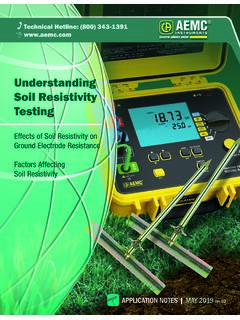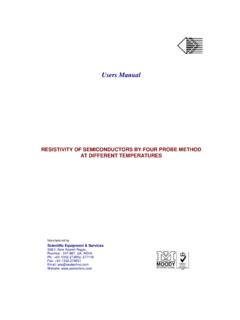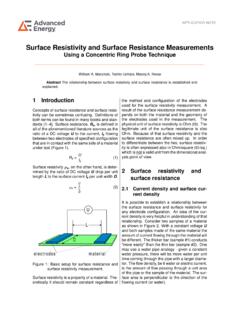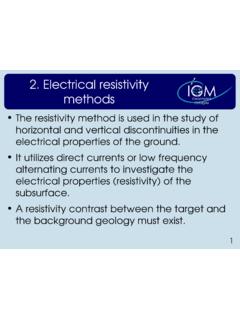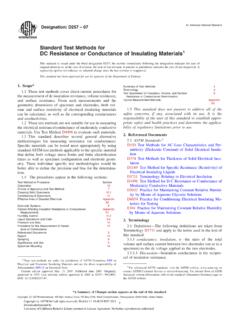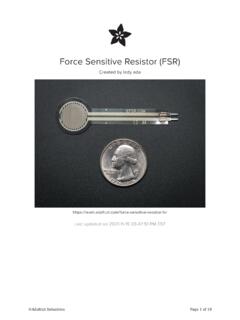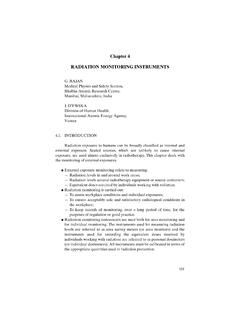Transcription of 17. RESISTIVITY THEORY 17.1 Introduction 17.2 Basic ...
1 Petrophysics MSc Course Notes RESISTIVITY TheoryDr. Paul Glover Page whole of RESISTIVITY logging is based upon a few very important equations which are introduced inthis section. The equations, which are known as the Archie Equations, relate the RESISTIVITY of aformation to the RESISTIVITY of the fluids saturating a formation, the porosity of the formation and thefractional degree of saturation of each fluid present.
2 As always, the story begins with Ohm s Definitions and Ohm s LawOhm s Law states that the current flowing from point A to point B in a conductor I is proportional tothe difference in electrical potential E between point A and point B. The constant of proportionalityis called the electrical conductance c. Current is measured in amperes (A), potential difference in volts(V), and conductance in siemens (S).Hence, we can write( )We also define an electrical resistance r, which is the inverse of conductance.( )Resistance is measured in ohms ( ). Hence, we can rewrite Eq. ( ) as( )Thus, if we take a cylindrical rock sample with two flat faces A and B, and set a potential difference E =EA-EB between its end faces, a current I will flow through the rock from face A to face B ( ).
3 If we measure the current and the potential difference, we can calculate the resistance of therock sample using Eq. ( ).Figure Ohm s Law for a rock =cr1=rEI =BAI EPetrophysics MSc Course Notes RESISTIVITY TheoryDr. Paul Glover Page 199 If the resistance is high, a given potential difference E will only give a small current I. If the resistance is low, a given potential difference E will give a high current value of resistance is a property of the material which describes how much the material resists thepassage of a current for a given applied potential that the size of our rock sample now changes.
4 If the length of the sample is doubled, one can see that the resistance of the sample to the passageof a current should also double. If the area perpendicular to the current flow doubles (the area of the end face in this example),there is twice the material for the current to pass through, the resistance of the sample to thepassage of the current should therefore fall to a half of what is was the resistance (and therefore conductance) depend upon the size of the we take the resistance per unit length and area, we can remove the effect of the dimensions of thesample. The value we obtain is then only a function of the property of the material and not itsdimensions.
5 The resistance per unit length and area is called the RESISTIVITY R, and can be expressed as( )where:R= the resistance of the sample ( m or ) E= the potential difference across the sample (volts, V)I= the current flowing through the sample (amperes, A)A= the cross-sectional area of the sample perpendicular to the current flow (m2)L= the length of the sample (m).Note that a conductivity C can also be defined as the reciprocal of the RESISTIVITY R, and therefore( )where:C= the conductivity of the sample (S/m).In petrophysical logging of electrical rock properties there are two main types of tool.
6 One typemeasures RESISTIVITY directly, and the result is given in ( .m). The other type measuresconductivity directly, and the result is given in either siemens per metre (S/m), or more often in milli-siemens per metre (mS/m). The two measurements are, of course, measuring the same property of therock, and can be interconverted using( )( )LAIER =ALEIRC ==1()() ()() MSc Course Notes RESISTIVITY TheoryDr. Paul Glover Page of RocksReservoir rocks contain the following constituents Matrix materialHigh RESISTIVITY Formation watersLow RESISTIVITY OilHigh RESISTIVITY GasHigh RESISTIVITY Water-based mud filtrateLow RESISTIVITY Oil-based mud filtrateHigh resistivityAll have a high electrical RESISTIVITY (electrical insulators)
7 Except the formation water and water-basedmud filtrate, which are good electrical conductors and have a low electrical RESISTIVITY of the reservoir rocks therefore depends only upon the water or water based mud filtrateoccupying its pore Formations. For uninvaded formations, the measured bulk RESISTIVITY of the rock dependsonly upon the amount of the aqueous formation fluids present in the rock, and the RESISTIVITY of thoseaqueous fluids. Since the amount of formation fluids depends both on porosity and water saturationSw, we can say that the RESISTIVITY of the formation Rt depends upon porosity , water saturation Sw, andthe RESISTIVITY of the formation water Rw.
8 This RESISTIVITY is called the true RESISTIVITY of the formation. Itis the RESISTIVITY of the formation in the uninvaded zone, where the rock contains some saturation of oilSo, gas Sg, and water Sw, and where So+Sg+Sw= aim is to use knowledge of the RESISTIVITY of the formation, together with independent knowledgeof the porosity and RESISTIVITY of the formation waters, to calculate Sw, and hence enable ourselves tocalculate the values of Rt range from to 2000 (5000 to mS/m).The uninvaded zone of formations is commonly only measured directly by the most deeply penetratingelectrical logging tools.
9 The shallower investigating tools measure the invaded zone. Hence, if onewants a RESISTIVITY reading for use in STOOIP calculations, one should always chose the deepestpenetrating electrical tool of those that have been Zones. In most cases there is an invaded zone, where the formation fluids have beendisturbed by the drilling fluid. The RESISTIVITY of the formation in this zone depends upon the resistivityof the mud filtrate Rmf, the RESISTIVITY of any remaining formation water Rw, the saturation of the mudfiltrate SXO, the saturation of the remaining formation water Sw (if any), and the porosity of the rock.
10 If these values and the depth of invasion are known, the RESISTIVITY measured in the invaded zone canbe corrected to account for the presence of the mud symbols used in electrical logging in the invaded borehole environment are shown in Fig. MSc Course Notes RESISTIVITY TheoryDr. Paul Glover Page 201 Figure Borehole invasion, and the symbols and PressureCalculating Formation Temperature.










